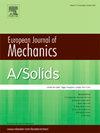A 3D visco-elasto-plastic damage constitutive model of concrete under long-term loads
IF 4.4
2区 工程技术
Q1 MECHANICS
引用次数: 0
Abstract
The present paper proposes a 3D coupled elasto-plastic damage model of concrete, incorporating long-term effects at the meso-scale. The model is able to capture permanent deformations, stiffness reduction and creep characteristics of concrete in a unified manner, including local confinement effects and stress concentrations of the cement matrix at the meso-scale. The modelling aspect related to plasticity is based on the pressure-dependent Menétrey–Willam plastic surface, extended to include a scalar damage variable accounting for the reduction in size of the elastic domain as concrete undergoes damage. The modelling aspect related to damage, on the other side, is inspired by the formulation of the isotropic damage by Mazars. Specifically, in the proposed formulation a stress-dependent damage variable is introduced to account for crack closure effects. The long-term effects are taken into account via the B3 creep model by Bažant and Baweja. Some challenging aspects related to the numerical implementation and interaction of the afore-mentioned models are addressed, amongst which the choice of a suitable loading scheme for the numerical implementation of the coupled model, and the mathematical derivation of the visco-elasto-plastic tangent operator. Numerical simulations are performed at the meso-scale, with the cement matrix being characterized by means of the visco-elasto-plastic damage constitutive model developed herein. The calibration of the model is discussed, and the numerical results at the meso-scale prove that the present model is fairly well capable of reproducing the creep failure of concrete materials, even when subjected to high loading levels.
求助全文
约1分钟内获得全文
求助全文
来源期刊
CiteScore
7.00
自引率
7.30%
发文量
275
审稿时长
48 days
期刊介绍:
The European Journal of Mechanics endash; A/Solids continues to publish articles in English in all areas of Solid Mechanics from the physical and mathematical basis to materials engineering, technological applications and methods of modern computational mechanics, both pure and applied research.

 求助内容:
求助内容: 应助结果提醒方式:
应助结果提醒方式:


